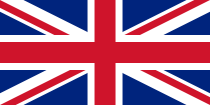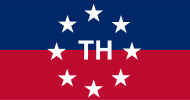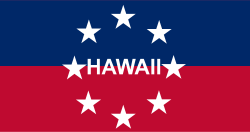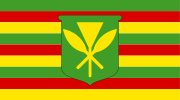Flag of Hawaii
Flag of Hawaii
 |
|
| Name |
Ka Hae Hawaiʻi |
| Use |
Civil and state flag  |
| Adopted |
December 29, 1845 |
The Flag of the State of Hawaii (Hawaiian: Ka Hae Hawaiʻi) is the official standard symbolizing Hawaii as a U.S. state. (The same flag had also previously been used by the kingdom, protectorate, republic, and territory of Hawaii). It is the only state flag of the United States to have been flown under so many various forms of government and the only state flag to feature the Union Flag of the United Kingdom, a holdover of the period in Hawaiian history when it was a British protectorate (1794–1843).
Design

The flag of Hawaii flying in Haleakalā National Park
The canton of the flag of Hawaii contains the Union Flag of the United Kingdom, prominent over the top quarter closest to the flag mast. The field of the flag is composed of eight horizontal stripes symbolizing the eight major islands (Hawaiʻi, Oʻahu, Kauaʻi, Kahoʻolawe, Lānaʻi, Maui, Molokaʻi and Niʻihau). A ninth stripe was once included representing the island of Nihoa. The color of the stripes, from the top down, follows the sequence: white, red, blue, white, red, blue, white, red. The colors were standardized in 1843, although other combinations have been seen and are occasionally still used.[1][2]
Origins
There are various accounts of the earliest history of the flag of Hawaii. One relates how King Kamehameha I flew a British flag, probably a Red Ensign, given to him by British explorer Captain George Vancouver as a token of friendship with King George III. Subsequent visitors reported seeing the flag flying from places of honor. An adviser to Kamehameha noted that the Union Flag could draw Hawaii into international conflict as his kingdom could be seen as an ally of the United Kingdom, and he subsequently lowered the Union Flag over his home at Kamakahonu. While disputed as historically accurate, one account stated that in order to placate American interests during the War of 1812, a flag of the United States was raised over Kamehameha's home only to be removed when British officers in the court of Kamehameha vehemently objected to it. This explains why the resulting flag of Hawaii was a deliberate hybrid of the two nations' flags.[3]
.svg.png)
British East India Company flag
In 1816, Kamehameha commissioned his own flag to avoid this conflict, which has evolved into the current flag. It was probably designed by one of the commanders of the Royal Hawaiian Navy, former officers of the British Royal Navy, who advised Kamehameha, based on a form of the British naval flag. There is debate as to the actual designer: some credit Alexander Adams, others George Beckley. It was very similar to the flag of the British East India Company in use about this time which had only red and white stripes. Captain Adams used this flag for the first time on a Hawaian trade mission to China in 1817.[4]

9-striped variant
The original flag was designed to feature stripes alternating in the order red-white-blue, also attributed to various historical flags of the United Kingdom. However, some have argued that the stripes were influenced by the flag of the United States. The flag used at the first official flying of the flag of Hawaii erroneously placed the stripes in the order white-red-blue.[5] The number of stripes also changed: originally, the flag was designed with seven horizontal stripes, and in 1845 it was officially changed to eight stripes. The latter arrangement was adopted and is used today.[3]
Chronology
| Date |
Flag |
Image |
| 1793–1794 |
British Red Ensign[5] |
 |
| 1794–1816 |
Union flag (probably not updated in 1801) |
.svg.png) |
| 1816–1843 |
Early version of the present flag |
 |
| Feb 1843-July 1843 |
Union flag (following British invasion) |
 |
| July 1843-Feb 1893 |
The current Hawaiian flag introduced following British withdrawal |
 |
| Feb 1893-Apr 1893 |
U.S. Flag |
 |
| 1894–1898 |
Hawaiian flag re-adopted by Republic of Hawaii |
 |
| 1898–1959 |
Hawaiian flag used by U.S. territory of Hawaii |
| 1959–present |
Hawaiian flag used by state of Hawaii |
Governor's flag
The flag used by the Governor of Hawaii is a red and blue bicolor. In the middle of the eight white stars appears the name of the state in all capital letters. During the time Hawaii was a United States territory, the letters in the middle of the flag were "TH", which stood for "Territory of Hawaii".[6]
 |
| Standard of the Governor before Statehood in 1959 |
|
 |
| Standard of the Governor of Hawaii |
|
Ka Hae Hawaiʻi day
In 1990, Governor of Hawaii John D. Waihee III proclaimed July 31 to be Ka Hae Hawaiʻi Day, the Hawaiian Flag Day. It has been celebrated each year since then.[7]
Kanaka Maoli flag

Kanaka Maoli flag
The Kanaka Maoli ("true people" in the Hawaiian language) flag is sometimes said to be the original flag of the Kingdom of Hawaii. To some, this flag symbolizes the Native Hawaiians since the present Hawaiian flag, a hybrid of British and American symbolism, evokes images of colonialism.[8] The colors are red-green-yellow, said to have been Kamehameha’s personal flag, and reintroduced by Kamehameha III. The central design is also present in the official coat of arms of the Kingdom of Hawai'i.
Gene Simeona of Honolulu claims he has recreated the "original" Hawaiian green, red, and yellow striped flag, destroyed by British navy Captain Lord George Paulet when he seized Hawaii for five months in 1843. Simeona says a descendant of Paulet he met on the grounds of ʻIolani Palace in 1999 told him the present Hawaiian flag is not the original. Simeona said he found the design in the Hawaii State Archives.[8]
At the center of the flag is a green shield bearing a coat of arms of the kanaka maoli, made up of the royal kahili, the original Hawaiian royal standard. Crossing this kahili are two paddles, representing both voyaging traditions of Hawaiians, and Kamehameha's Law of the Splintered Paddle. There are nine stripes unlike the eight striped flag of the present State of Hawaii. Each stripe represents one of the inhabited Hawaiian islands. They are Hawaii Island, Maui, Kahoolawe, Lanai, Molokai, Oahu, Kauai, Niihau, and Nihoa. According to this flag's promoters, the green in the flag represents the maka 'ainana (commoners), the land and goodness; the red represents the landed konohiki (middle class), genealogy and strength; and the yellow represents the aliʻi, spirituality and alertness to danger.[8] Other flags have been proposed, and interpretations of colors,[9] but even leaders of the Hawaiian sovereignty movement often use the current state flag, since it was in effect after 1843.[10]
See also
- State of Hawai'i
- Symbols of the State of Hawai'i
- Great Seal of the State of Hawai'i
References
External links
|
Flags of the US states, federal district, and insular areas |
|
| States |
Alabama · Alaska · Arizona · Arkansas · California · Colorado · Connecticut · Delaware · Florida · Georgia · Hawaii · Idaho · Illinois · Indiana · Iowa · Kansas · Kentucky · Louisiana · Maine · Maryland · Massachusetts · Michigan · Minnesota · Mississippi · Missouri · Montana · Nebraska · Nevada · New Hampshire · New Jersey · New Mexico · New York · North Carolina · North Dakota · Ohio · Oklahoma · Oregon · Pennsylvania · Rhode Island · South Carolina · South Dakota · Tennessee · Texas · Utah · Vermont · Virginia · Washington · West Virginia · Wisconsin · Wyoming
|
|
| Federal district |
Washington, D.C. (District of Columbia)
|
|
| Insular areas |
American Samoa · Guam · Northern Mariana Islands · Puerto Rico · U.S. Virgin Islands
|
|
 Book:Flags of the U.S. states · Book:Flags of the U.S. states ·  Category:United States state flags · Category:United States state flags ·  Portal:Heraldry Portal:Heraldry |
|
|
National and regional flags incorporating the Union Flag |
|
| Sovereign nations |
|
|
| Dependent territories |
Of New Zealand: Cook Islands · Niue
Of the United Kingdom: Anguilla · Bermuda · British Antarctic Territory · British Indian Ocean Territory · British Virgin Islands · Cayman Islands · Falkland Islands · Montserrat · Pitcairn Islands · Saint Helena (and its dependency Tristan da Cunha) · South Georgia and the South Sandwich Islands · Turks and Caicos Islands
|
|
| States and provinces |
Of Australia: New South Wales · Queensland · South Australia · Tasmania · Victoria · Western Australia
Of Canada: British Columbia · Manitoba · Ontario
Of the USA: Hawaii
|
|
| Cities |
|
|
| Miscellaneous |
|
|


.svg.png)



